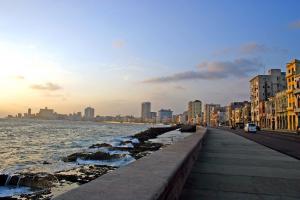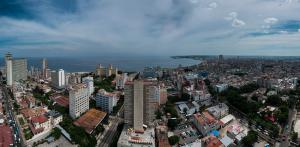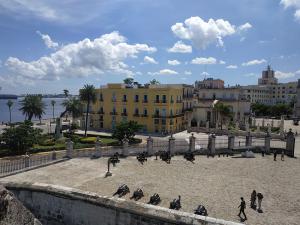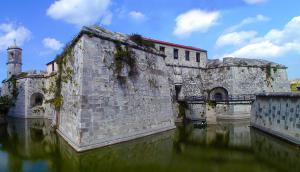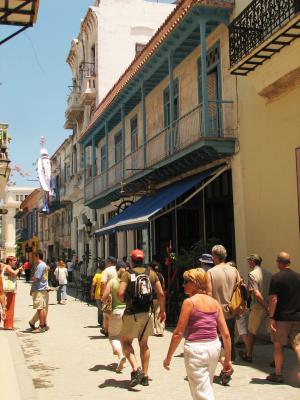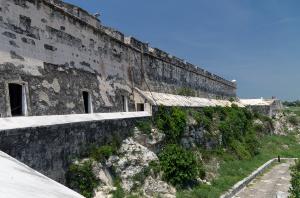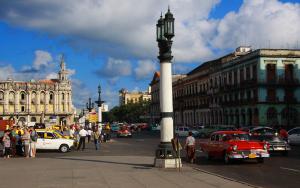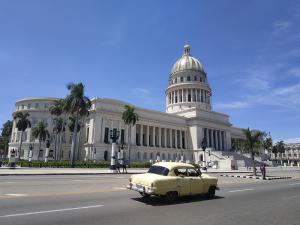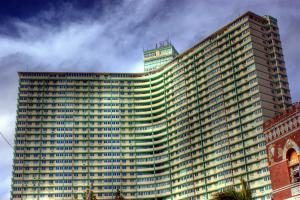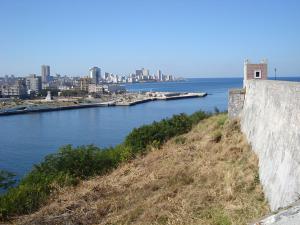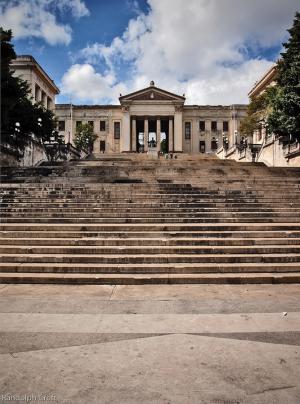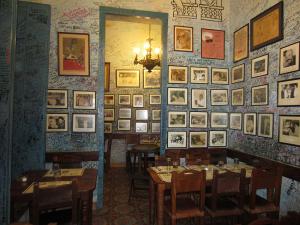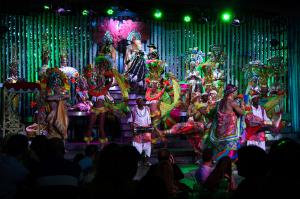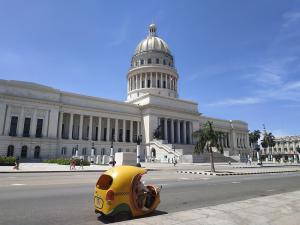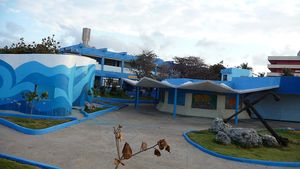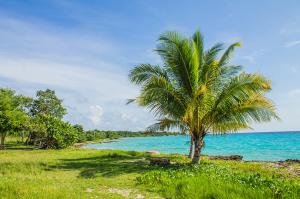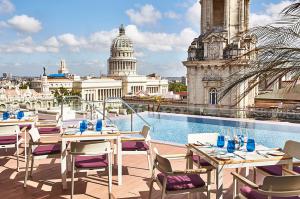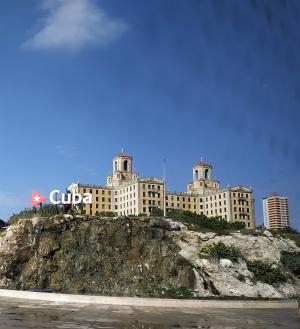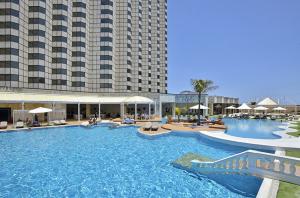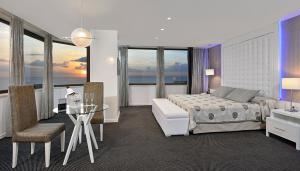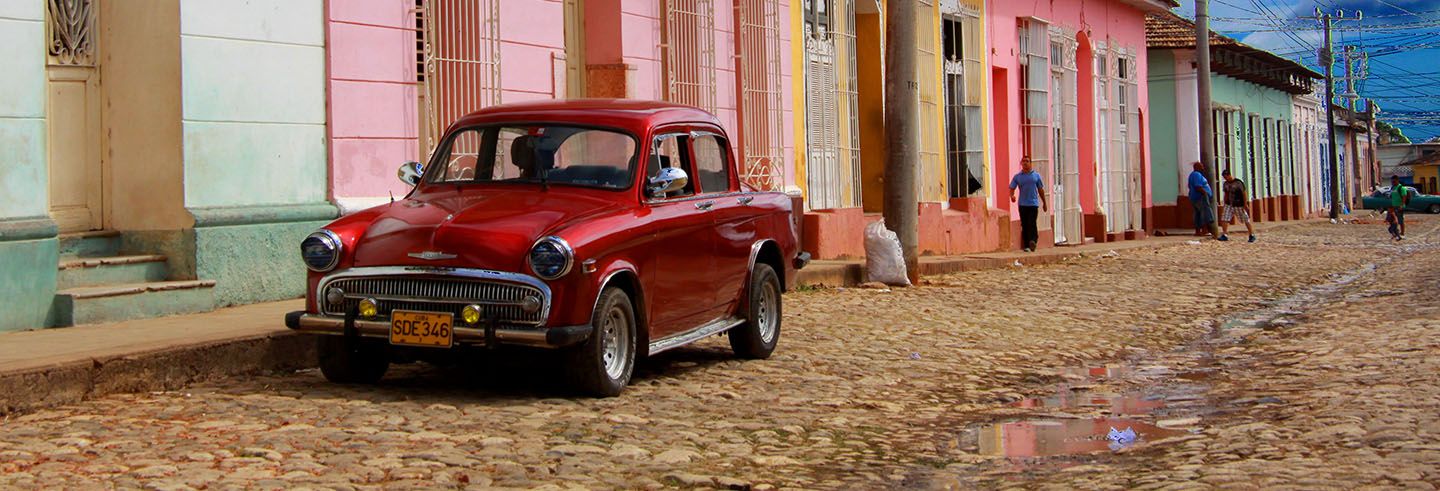

Havana, Cuba
Travel to Havana, the capital of Cuba, and discover the enchantment of a city full of history, music, and happiness
Havana, capital of Cuba, is a city in which music and color bloom from each one of its lively streets. The magnificent architecture of its buildings and the antique homes that envelope them make each area of the city identify with a distinct period in the country, from colonial times to revolutionary ones, passing through its American period. Its extraordinary cultural offering and exotic atmosphere make it a destination worth visiting, at least, once in a lifetime.
One of the many enchantments of the city is to see the day to day life of the Havana residents. Especialmente in Old Havana, its historic district, where the town finds itself debating about the latest baseball game or, simply living and enjoying life between the beautiful plazas and the small antique book markets.
Considered one of the best places to travel in all of Latin America, all those who visit Havana fall in love with the place. A lively city, with colorful streets that run through the city in allowing the visitor to know everything that is held within its interior, from the baroque architecture of the Cathedral of Havana, passing by the unique environment of El Malecón and the luxurious Grand Theater of Havana Alicia Alonso, to the newer and modern buildings of the Vedado.
The capital of Cuba, is the artistic symbol of the entire country, and artistic treasure not only in its many and interesting museums, rather that many of the well known streets, like the callejón de Hamel, have spectacular murals and impressive sculptures on their walls visible to all those who pass there.
Without a doubt, the culture of Havana has a lot to offer. The automobile park with the characteristic classic cars of the city take you back to the 50’s, the music in every corner by the hands of trovadores or the great musicians that intonate the Cuban son, joyful young people that pass through the old streets and incredible stories about the city, make up Havana, an experience, a place and an atmosphere that is unique in the world.
Index:
- What to see in Havana, Cuba?
- What to do in Havana, Cuba?
- What to do in Havana with kids?
- Which excursions are there to do from Havana?
- Where to stay in Havana?
- How to get to Havana, Cuba?
- What is the best time to go to Havana?
What to see in Havana?
In Havana the old and the new live together in open harmony, giving the city a unique atmosphere that you can see reflected in the three main areas and in the areas where a large part of the historic buildings of the city are concentrated: Old Havana, The Havana Center and the Vedado.
Old Havana, with its colonial origin and declared a World Heritage site by UNESCO, is an essential stop in your trip to Cuba. The Havana Center is a neighborhood replete with tranquil parks in which you can rest after getting to know the symbolic buildings that they host; and the Vedado, located in the municipality of the Plaza of the Revolution, is the most splendid zone of the city in which you will find marvelous luxury hotels.
To visit Old Havana is to know the origins of the Cuban Capital.The best way to feel its essence is to walk through its cobblestone streets, taking all the time in the world to observe every detail of the magnificent buildings and the Cuban atmosphere.
Built around four colonial plazas, in this area you will be able to contemplate the most impressive structures. Among them are the imposing Cathedral of Saint Christopher of Havana, where you will see characteristic elements of Cuban baroque, in the Cathedral Plaza; the old Castle of the Royal Force, declared a World Heritage Site by UNESCO, is one of the most amazing fortresses of military architecture in Cuba, located in the Main Plaza. Located in the Plaza of Saint Francis of Assisi is the great Church and Convent of Saint Francis of Assisi, a majestic religious temple that currently houses the city's Museum of Sacred Art.
The symbolic origin of Havana is found in El Templete, a small temple of Greek and Roman architecture, built in the place where the city was founded more than 500 years ago.
The Mercaderes street is cobbled and wide avenue that keeps in tradition all the charm of the colonial period. Known for hosting a great number of buildings, there you will find the The Model Museum of Old Havana, a model of the historic district of the city continuously kept up to date, that will help you in your touristic visit and you will be amazed by the minute details of the buildings.
In the colonial period, the city was frequently attacked by pirates and corsairs. To stop them, it was decided to construct three military forts in the defense of the city: the The Castle of the Three Kings of the Morro, the Fortress of Saint Charles of the Cabaña and the Castle of the Holy Savior of the Punta. Until nowadays you can visit the first two forts in the Historic Military Park of Morro-Cabaña, an emblematic place from which you will have beautiful views of the captivating city. On the other hand, the Castle of the Holy Savior of the Punta is found on the other side of the entrance to The Bay of Havana, at the beginning of El Malecón.
If you want to know more about the history of the city, the best option is to visit the Museum of the City, in the Central Plaza. In its rooms and expositions, the objects and the photographs tell the story of the Cuban capital. It is located in the Palace of the Captain Generals, a magnificent baroque building that hosts the Office of the Historian of the City.
An institution of great importance in the recovery of the historic center of Havana: it was the first to start the process of restoration of the buildings of great architectural value, such as the Castle of the Royal Force or the Palace of the Second Corporal; it created schools and health centers in Old Havana; and rehabilitated many public spaces that now are the nucleus of the capital, like the four colonial plazas: the Main Plaza, the Old Plaza, the Cathedral Plaza and the Plaza of Saint Francis of Assisi.
El Malecón, Symbol of the city, is a large and very famous seafront promenade in Cuba that acts as a meeting point for the population. Stroll along contemplating the beautiful panoramic views of the sea and the gentle sea breeze, admiring the warm sunsets while you are invaded by the cheerful Cuban son played by local musicians, or listening to a poet reciting his wonderful verses for everyone who is present. It is music that seduces you and that, when it plays, the most spontaneous Havana residents do not take long to come and dance, enjoying the moment and spreading the joy to those around them.
The Center of Havana is known for being a lively municipality full of beautiful buildings with exceptional architecture. Strolling along the wide and beautifully built Paseo del Prado, you can shelter yourself from the sun under the shade of the leafy trees while enjoying a path surrounded by beautiful mansions and buildings, luxurious theaters and the characteristic colorful Havana houses.
A lively stroll through the impressive Great Theater of Havana Alicia Alonso, one of the most luxurious in the country and the continent, with a neo-baroque style and home to the National Ballet of Cuba. At the end of which is located the imposing National Capitol of Cuba, a construction based on the Capitol of Washington, and whose dome bears a great resemblance to that of St. Peter's Basilica in Rome.
This area is known for its quiet parks, away from the typical hustle and bustle of other areas of the capital. At the end of the walk you will find the Park of Fraternity, a beautiful space with green areas in which to rest in front of the National Capitol. Nearby is the Central Park, a peaceful place full of tall trees and palms like towers in the center of which stands the statue in honor of the National Hero, José Martí. Surrounded by some of Havana's most emblematic buildings, it is an ideal place to enjoy Cuban life.
Visit the neighborhood of Vedado and you will feel like you are traveling to a different city. Located in the municipality of Revolution Plaza, its residential streets have nothing to do with what is already seen in the capital, but are rather reminiscent of a large American city. This commercial and economic center is home to everything from magnificent stately homes of a more classical style to extraordinary art deco buildings and impressive luxury hotels.
Here you can visit the impressive FOCSA Building, located in a residential area among small houses. Inside you will find a shopping mall and the restaurants La Torre and El Emperador, where you will have extraordinary views of the city and the vast sea. Considered one of the seven wonders of Cuban civil engineering, it marked the beginning of the construction of tall buildings in the country.
The Revolution Plaza, which lends its name to the municipality, has great historical value for the city, as it has become the most emblematic place of celebration. All types of events have been held there, from political or solidarity movements, to anniversaries of events or student graduations. To the north of the esplanade is the José Martí Memorial, a towering star-shaped building in memory of José Martí and at the base of which is a museum dedicated to this National Hero, which you can see during your visit to Havana Center.
To get to know Havana well and savor the essence of the city, the ideal length of your stay should be at least 3 days. There is much to discover in this wonderful city and its surroundings, areas that are authentic beauties and that will allow you to explore more of Cuban history.
To the east of the capital of Cuba are small populations to be found such as the Guanabacoa, a place replete with traditions that have their roots in the fusion of Catholic and African religions; and Regla, a municipality with an industrial origen in which is found the community of Casablanca, where you will see the Statue of Christ of Havana and a view to contemplate some of the best vistas of Old Havana.
15 kilometers of paradisiacal beaches of white sand and crystal water awaits you in the Eastern Beaches, including Saint Maria of the Sea and Guanabo, two places in which to disconnect and enjoy the peace and to breath; and Cojímar, a small population of fishermen that rises around the Torreón de Cojímar, an old spanish fortress that has all the enchantment of an older time,and takes part in the defence of Havana.
On the other hand, to the west of the city is Miramar, a modern area in which you can delight yourself with the exquisite gastronomy of restaurants like El Aljibe or Don Cangrejo and enjoy the short boat ride in the Marina of Hemingway.
What to do in Havana, Cuba?
Havana, a city that breathes happiness, the colors of the streets will stay recorded in your retina, and the friendliness of the people that you meet there will stay with you for the rest of your trip.
In the Cuban capitol there are activities for all interests and ages, from visiting museums to snorkeling, passing by to admire cuban art and enjoy the best musical nights you have ever seen.
To walk through Old Havana is the best way to get to know the oldest area of the city. Walking through the colorful streets will allow you to discover the architectural jewels that are inside. Enjoy the cuban ambiance that breathes in it's plazas while you visit the little markets that they organize in them, and the sound, the most typical songs of the capital that you will hear throughout your journey.
The historic district houses in its interior a number of museums that span the most varied interests. The Museum of Rum Havana Club, the museum of tobacco and the museum of chocolate are the three sites in which to get to know first hand the fabrication of some Havana products; or the automobile museum, in which you will see from horse drawn carriage to the most modern automobile of 1989.
The lovers of art will find here the National Museum of Fine Arts, in which they will be able to know the history of Cuban art and admire both works by national and international artists; and the Museum of Mural Paintings with impressive canvases. In addition, at the Cuban Art Factory "FAC" in the Vedado neighborhood they will enjoy the plastic works of various local artists, as well as music, architecture and theater from the country, an experience for the senses.
Walk through the Morro-Cabaña Military Historical Park late in the afternoon and you will be able to see the Cannonball Ceremony, an act that takes place every day at 9 p.m. and that for a moment returns Havana to colonial times and from where you will have fantastic views of the pier.
A comfortable and different way to get to know the city is through a ride in a classic car. In the car park, a multitude of vehicles await you with which to make a route through the most important and tourist areas of the Cuban capital. The style of many of the buildings together with the vintage cars will make you feel back to the 50s, which will make your walk a unique experience on your trip.
Enjoy the best ice cream in the city at the emblematic Coppelia Ice Cream shop on your way through the Vedado neighborhood, and the Cristóbal Colón Necropolis, the largest and most important funeral complex in the entire country, declared a National Monument.
The first university in Cuba, and also one of the first in all of America, is located in the Cuban capital. The University of Havana, a majestic neoclassical building declared a National Monument and of great importance for the city, is located in the Vedado neighborhood. Climb the grand staircase that precedes the central building and you will see the imposing sculpture of the Alma Mater, close to which is the Felipe Poey Museum of Natural History, the oldest in the country, where you can see various collections of native flora and fauna ; and the Montané Anthropological Museum, where pre-Columbian objects are exhibited.
Havana has been the place of passage and residence of many famous international figures. Their presence at La Bodeguita del Medio and El Floridita to enjoy their two exotic Cuban drinks have made them two places of gastronomic worship and great tourism in the city.
La Bodeguita del Medio has filled its walls, over the years, with the signatures of the best-known figures who have passed through there, including Ernest Hemingway, Pablo Neruda and Gabriela Mistral. There you can taste the most authentic mojito in all of Cuba, recommended by everyone who visits it, and delight yourself with the exquisite typical Creole food that they offer while enjoying live Cuban music.
And El Floridita, considered by the North American Academy of Gastronomic Sciences as the King of the Daiquirí, is the best place to have it. He savors this delicious cocktail together with a good plate of traditional Cuban food and in the company of Ernest Hemingway, who made this bar and restaurant famous with his frequent visits, and whose statue presides over the bar inside the premises.
Music will accompany you on your trip to the capital of Cuba, a place with rhythm in the environment. Stroll through the beautiful city while you fall in love with the melodies that you will hear practically in every street you pass. Led by troubadours and small musical groups, enjoy the incredible live music in the restaurants and bars of the city, as well as in the wonderful shows that will enliven your stay in Havana.
One of the most coveted spaces in the city to enjoy Cuban music is the Habana Café, where native melodies that join a traditional dance show is what makes this place so special.
Let yourself be carried away by the sound and the Caribbean notes at the Cabaret Parisien with a wonderful intercultural show in which dance takes control of the night. Or at the Tropicana Cabaret, known as Paradise under the stars, where you will enjoy the amazing open-air show full of color that is offered there.
Contemplate the various modalities of Cuban art in the Cuban Art Factory "FAC", a temple of contemporary art. With three rooms dedicated exclusively to music, in them you can witness live concerts of classical, Cuban or small groups that are beginning their musical career. There you will appreciate the always full walls that display photographs and works of plastic arts, the impressive exhibitions of architecture and industrial design, and the magnificent theatrical and dance shows. In addition, you can attend numerous talks and events that are held for each of the disciplines.
Lovers of active tourism and nature will find activities in the capital of Cuba to make the most of their stay. If you like water activities, you can snorkel or dive in the beautiful coral reefs that line the Havana coast. And if what you want is to be in contact with green nature and ecotourism, visit the beautiful Almendares Park and its abundant tropical vegetation, the incredible Rincón de Guanabo and the magnificent Laguna del Cobre Itabo, two Protected Natural Areas, which are the perfect places for you.
In addition, various sporting events are held in the city, such as the Marabana, the city's marathon in which registrations are open to the public, which is held in November; or the famous Ernest Hemingway International Marlin Fishing Tournament held in June at the Hemingway Marina.
What to do in Havana with children?
Cuba is an excellent country to visit with children and, as in Havana, families will have truly unique experiences during their trip.
The Cuban capital and the country, in general, are places with a high level of security on their roads and establishments. Thanks to the police presence and the awareness and involvement of the population to avoid any type of altercation, Cuban streets are some of the safest in which to walk as a family without any concern.
The most popular means of transport in the city, such as Cocotaxi or classic cars, are very good options to get to know the beautiful city with the little ones, in a more comfortable way, and without missing any of the Havana charm.
Practically all the places that can be visited in the city are perfect for children, as well as the activities, such as the Cannon Ball Ceremony in the Morro-Cabaña Military Historical Park, visiting the many and interesting museums that the city houses or enjoying a delicious ice cream at Coppelia. Even so, there are many plans and visits more focused on the little ones so that they can have the most fun on their visit to Havana.
The most curious children will love the Planetarium of Havana, with interactive areas and large scale planets; the Museum of Natural History of Cuba, where you can see the evolution of life and exhibitions on Cuban nature; and the Camera Obscura, located in the Gómez Vila building, where children will learn about this ancient contraption while being amazed at the 360º views of the city. Three interesting places where you will enjoy learning about Cuba while having fun, located in Old Havana, near many other buildings of great importance.
The National Aquarium of Cuba in Miramar is an ideal place where you will discover the impressive fauna and marine landscapes of the area. In the National Zoological Park of Cuba you will know the national fauna as well as some endangered species. Both are located in the vicinity of Lenin Park, as well as the Equestrian Club, where the little ones can experience riding a horse and spend an endearing time in their company.
Also in Lenin Park is the Amusement Park, a small attraction park in which to have fun and in whose surroundings you will find magnificent restaurants.
Almendares Park, the lung of Havana, awaits you to meet the amazing dinosaurs it houses, to spend a fun afternoon playing miniature golf or to enjoy a boat ride on the Almendares River.
What excursions can be done from Havana?
Havana has an ideal geographical location to make short one-day trips to other nearby points in Cuba. This will allow you to know the extraordinary landscapes, culture and charms of the towns you visit without having to worry about accommodation.
From the Cuban capital you can take the excursion to Cayo Largo, relax on the most paradisiacal beaches in the entire country, where you will enjoy a peaceful atmosphere. Have fun with water activities, such as catamaran rides, and let yourself be carried away by its crystal clear waters where you will see starfish and turtles in their natural habitat.
On the excursion to Varadero you will find incredible beaches of fine sand, in addition to visiting the Bacunayagua bridge, the highest in Cuba, and navigating the mighty Canímar River, which is surrounded by lush vegetation.
Admire the Mural of Prehistory and explore the interior of the Cueva del Indio with the excursion to the Viñales Valley. Declared a Natural Cultural Landscape Protected by UNESCO and a National Natural Monument, Viñales is a beautiful valley where you will enjoy the panoramic views with mogotes and the bright colors of the vegetation. During your visit, get to know the Balcony of Viñales and the way of manufacturing rum and tobacco and its history.
Spend a sunny day at sea with the magnificent Safari Cayo Blanco maritime excursion. You will visit the key in comfortable sea boats and you will be able to snorkel to see the wonderful coral reefs and colorful tropical fish that inhabit its crystal clear waters. Meals throughout the day will take place on the shore of the quiet beach with authentic Cuban menus, a delight for the palate.
If you are interested in bird watching, the excursion to the Zapata Swamp is perfect for you. With more than 200 different bird species and a great variety of endemic plants, the wetland is declared a Biosphere Reserve. Its crocodile farm is one of the main tourist attractions in the area. There you can also get to know the Bay of Pigs and Girón Beach, well known both for their historical role and for diving and snorkeling, given the great marine life that their waters hide.
Within Havana there are also small excursions that will enrich your trip and that will allow you to learn more about Havana culture.
With the Hemingway Route you will walk in the footsteps of the famous American writer. You will visit the places he frequented the most, such as the Ambos Mundos Hotel or Cojímar, without forgetting his visit to La Bodeguita del Medio.
On the Yoruba Religion Tour, you will visit the Cuban capital to learn the best kept secrets of Santeria, a religion with roots in West Africa and that arrived in Cuba in colonial times.
If your time of stay in the city is limited, you can do a City Tour on foot through Old Havana or a ride in a classic car, always accompanied by a specialized guide, who will show you the most emblematic places of the city, and the stories and legends that surround every street.
Where to stay in Havana?
One of the best options to get to know Cuban culture from the inside is by staying in a private house. This type of accommodation will give you a much more authentic and closer perspective of life in the capital of Cuba, giving you the opportunity to get to know in depth its passionate culture and way of life. You will enjoy interesting conversations and genuine Havana stories that give Havana the charm of a legendary city, as well as valuable advice that will undoubtedly help you make the most of your stay.
If you prefer to stay in a hotel, the city has a wide range of hotels for all tastes and needs.
Old Havana is one of the quietest and safest areas of the city. Being the historic center, many of the hotels are located inside incredible buildings and have views of the most magnificent monuments that you can enjoy just by looking out the window of your room.
An excellent accommodation option is the Gran Hotel Manzana Kempinski, from which you will have beautiful views of the city that you can enjoy from the comfort of its charming rooms. Close to its location is the Iberostar Parque Central Hotel, in colonial style and with a large swimming pool on its roof, which also has several bars and restaurants nearby.
The Plaza Hotel, located in one of the oldest areas of Havana, with modest rooms, has an impressive entrance hall on the ground floor as well as a small garden on the fifth floor. Next to it are the Hotel Inglaterra, the oldest and most prestigious in the whole city and located in one of the most emblematic places of the capital, and the Hotel Mercure Sevilla Havane, with a Mudejar style entrance and an interior patio reminiscent of the Sevillian courtyards, well-known figures such as Al Capone or Luis Rodríguez Olmos have passed through it. Offering excellent qualities.
Overlooking the Bay of Havana and in the heart of Old Havana is the Hotel Santa Isabel, declared a Cultural Heritage of Humanity. With a stately atmosphere, it is the perfect accommodation if you want to enjoy the charm of the oldest part of the city. And the impressive and innovative Iberostar Grand Packard Hotel, with panoramic views of the Morro-Cabaña Military Historical Park, offers one of the best services and qualities in the entire city.
Central Habana is an area where you can enjoy the joy and color of its streets. Known for housing iconic buildings, it also has modern accommodation, cheaper than in other parts of the city.
The SO Paseo del Prado Hotel is an elegant and modern hotel that offers the maximum comforts and beautiful views of the Morro-Cabaña Military Historical Park and El Malecón. Located on the Paseo del Prado is the Hotel Telégrafo, a charming hotel specialized in Cuban haute cuisine and that inside houses a space used as an art gallery.
The Hotel Deauville is located right in the El Malecón promenade, with incredible panoramic views of the sea and the fortresses of the Castillo de los Tres Reyes del Morro and the San Carlos de la Cabaña Fortress; and the Terral Hotel, with an avant-garde urban design, provides privacy thanks to its private terraces from which to enjoy the privileged views.
The Vedado neighborhood is a totally different area to stay. A former mafia fiefdom converted into a residential neighborhood, its buildings are reminiscent of a great American city. In addition, it is the largest commercial and leisure area in Havana, so you will always have shops of all kinds and a great cultural contribution within reach. In it are the most luxurious hotels in the city.
A very good accommodation option is the Hotel Nacional de Cuba, an emblematic building of the city declared a National Monument, which offers excellent quality services and its magnificent eclectic architecture impresses the eyes of those who admire it. In the same area is the NH Capri La Habana Hotel, a modern hotel with a rooftop pool that will provide you with all the necessary amenities on your trip.
The Tryp Habana Libre Hotel, one of the tallest buildings in the country and former property of the Hilton hotel chain, is located close to the main points of interest in the city and has magnificent qualities. In addition, in its building you can see two works of art: the Mural of Amelia Peláez and the sculpture La Clepsidra. Near El Malecón is the Hotel Meliá Cohiba, an elegant hotel where you can enjoy its extraordinary services, its outdoor pool and the impressive views it offers.
Some cheaper accommodations are the Hotel Vedado, a quiet hotel near El Malecón, and the Hotel Colina, with a family treatment and a short distance from the University of Havana.
Finally, and further away from the main points of interest in Havana, is Miramar, located in the municipality of Playa, an area that stands out for its residential buildings and where you can see various houses and spas with a special charm.
There, the Hotel Meliá Habana stands out, an incredible tourist complex with beautiful green areas in which to rest and highly recommended for honeymoons and families.
How to get to Havana, Cuba?
Havana is a very well connected city, both by land and by sea and air. Depending on where you come from, you will find various arrival options to suit your needs.
If you are traveling from another country, the best way to get to the city is by plane, landing at the José Martí International Airport which is located just 20 km from Havana. Once there, the easiest thing will be for you to take a taxi to the point of the city that you want.
If in your case you are traveling on a Caribbean cruise, you will arrive at the Sierra Maestra Cruise Terminal, in the historic center, so you will not have to travel to enjoy the most emblematic buildings of the city.
On the other hand, if you are traveling from another area of Cuba, you have several options available depending on where you are. The roundtrip excursions on the same day will allow you to get to know Havana and feel its essence without having to worry about transportation.
Another very good option is the bus transportation to get from places like Trinidad, a beautiful colonial city; Varadero, east of Havana, a true paradise of tropical beaches; or Viñales, an oasis of lush endemic vegetation in western Cuba. In this transport you will arrive at the National Bus Terminal in the Vedado neighborhood, near the Plaza de la Revolución.
To get to the city from the most remote areas of Cuba, your best option will be air transport. Several cities and small locations in the country have an airport, among which are Santiago de Cuba, the second most important city, where you can enjoy the charm of its streets; Baracoa, where you can explore its incredible mountains full of lush endemic vegetation; or Cayo Largo del Sur, Cayo Santa María, Cayo Coco or Cayo Guillermo, islands with wonderful virgin beaches. If you are in a town close to one of them, you can move and use this transport to get to Havana.
Finally, the most independent transport is the rental car, with which you can move without defined schedules, stop to admire the wonderful landscapes or the small and beautiful towns that you will find on your trip to Havana.
What is the best date to go to Havana?
Cuba has a tropical climate, which makes Havana a city that you can visit throughout the year. Its warm temperatures, which vary between 22ºC and 30ºC, will allow you to enjoy its wonderful beaches and the infinity of outdoor activities that the Cuban capital offers.
The best dates to go are in the dry season, from November to May, where you will find cooler temperatures and little rainfall. In addition, they are outside the hurricane season.
On the other hand, the wet season covers the months from June to October, where the days will be hotter and the rains more frequent.
During the high season of tourism in the city, which covers the months of January, December and August, people from the rest of the world and other parts of the island come to Havana to discover the charm of the city and the joy of its people. August is the most popular month to visit it.
During this period, events of great importance are held, such as the Festival of New Latin American Cinema, a contest in which the transmission of the values of Latin American culture is sought, in December; or the Havana Carnival, in August, a celebration where traditional music, the impressive floats that parade along the Malecón, and the color and joy of Cuban culture are the main protagonists.
On the contrary, the low season of tourism occurs from the end of April to June and in September and October, coinciding with the hottest months of the year and the rainy season. Although it is not within the low season, February is the cheapest month to travel to Havana, time in which the International Jazz Plaza Festival is celebrated, where great artists from all over the world attend and where you will enjoy the wonderful improvisations typical of this genre.
In addition, the Havana Vieja International Festival: Ciudad en Movimiento, an event held in April, will connect you with the dance, art and architecture of the oldest neighborhood in Havana and one of the most beautiful in Cuba; in June the Ernest Hemingway International Marlin Fishing Tournament is held, in which participants and boats from all over the world arrive in the city; and in October the International Ballet Festival of Havana, in which dance takes center stage and where you will enjoy magnificent performances.
Interactive map:
Havana:
Old Havana
- Cathedral Square
- Havana Cathedral
- Conde de Lombillo Palace
- Palace of the Marqués de Arcos
- Marqueses de Aguas Claras Palace
- Mural Art Museum
- Museum of Colonial Art
- Callejón del Chorro Alleyway
- La Bodeguita del Medio
- Plaza de Armas Square
- Segundo Cabo Palace
- City Museum
- La Real Fuerza Castle
- Navigation Museum
- El Templete
- Cuban Natural History Museum
- Mercaderes Street
- Tobacco Museum
- Model Museum of Old Havana
- Asia House Museum
- Simón Bolívar House Museum
- Casa de la Obra Pía Museum
- Museo Casa de África (Africa House Museum)
- Oswaldo Guayasamín House Museum
- Museo Armería 9 de Abril (Armory Museum April 9)
- Museo de los Bomberos (Firefighters Museum)
- Museo del Chocolate (Chocolate Museum)
- Obispo Street
- Museo de la Orfebrería (Silversmithing Museum)
- Museo de Pintura Mural (Mural Art Museum)
- 28 de Septiembre de los CDR Museum
- Museo Numismático (Numismatic Museum)
- Museo Casa de México Benito Juárez (Benito Juárez House of México Museum)
- Museo de la Farmacia Habanera (Havana Pharmacy Museum)
- San Francisco de Asís Square
- San Francisco de Asís Church
- Museum of Religious Art and History in Old Havana
- Automobile Museum
- Old Town Square
- Centro de Arte La Casona (La Casona Art Center)
- Fototeca de Cuba (Cuban Photo Library)
- Planetarium of Havana
- Naipes Museum
- Pablo de la Torriente Brau Cultural Center
- Casa Alejandro de Humboldt Museum
- Museo del Ron (Rum Museum)
- Nuestra Señora de Kazán Orthodox Cathedral
- Bacardi Building
- Plaza del Cristo
- Santo Cristo del Buen Viaje Church
- Santo Ángel Custodio Church
- Iglesia Parroquial del Espíritu Santo (Church of the Holy Spirit)
- Santa Clara Convent
- Convento de Belén (Belén Convent)
- Iglesia de San Francisco de Paula (San Francisco de Paula Church)
- Casa Natal de José Martí Museum
Centro Habana
- Capitolio Nacional de Cuba
- Gran Teatro de La Habana Alicia Alonso
- Paseo Martí
- Museo de la Revolución
- Museo Nacional de Bellas Artes
- Real Fábrica de Tabacos Partagás
- San Salvador de la Punta Castle
- Iglesia del Sagrado Corazón de Jesús
- Hotel Inglaterra
- Havana's Chinatown
- Parque de la Fraternidad
- Fuente de la India
- Monumento a Máximo Gómez
- Casa Museo José Lezama Lima
Vedado
- El Malecón
- Cabaret Parisien
- Hotel Habana Libre
- Cementerio Colón
- Hotel Nacional de Cuba
- University of Havana
- Teatro Nacional de Cuba
- Avenida de los Presidentes
- Revolution Square
- Napoleonic Museum
- Museo Napoleónico
- Casa de las Américas
- Museo Nacional de Artes Decorativas
- Parque John Lennon
- Museo de Historia Natural Felipe Poey
- Museo Antropológico Montané
- Monumento a Julio Antonio Mella
- Edificio Focsa
Other nearby destinations:
Why "Cuban Travel Agency"?
"Cuban Travel Agency" is part of the Visitar Cuba project, an organization of Cuban agencies whose objectives are:
- ✓ Disseminate Cuba, its culture and its heritage.
- ✓ Promote sustainable tourism.
- ✓ Support the local economy, prioritizing direct contact with Cuban agencies.
- ✓ Offer budgets without commitment and without cost, from the hand of Cuban experts.
Travel agencies and Tour Operators
If you are an agency or tour operator and you are looking for help to create trips to Cuba, trust our expert hands, we offer special prices.
© www.CubanTravelAgency.Org - All rights reserved.



